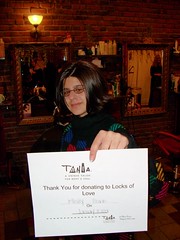As I've mentioned before in my blog posts, we're redoing our entire kitchen as the result of a water leak. The insurance company gave us a settlement, which was enough to buy some really nice cabinets to replace the ones we lost. But my wife ran that female equation in her head and decided we should buy less expensive cabinets, which will leave us enough money to do the floors. But of course, you can't put in a new kitchen without new appliances, and before you know it, we've hired a contractor and spent way more than the insurance company gave us.
One reason the cabinets are cheap is because we bought them at IKEA, which means I had to spend a couple of weekends assembling the cabinet shells. Because IKEA is a multinational company, the instruction booklets that come with them are printed with a numbered series of illustrations that are intended to show you how to assemble the components. But there are no words, because they'd need to have them in 40 languages and the books would be 100 pages long. So it's all done with manipulation drawings:

These instructions are sometimes simple and obvious, and other times force you to sit in a cramped position on the living room floor turning the pieces over in your hands and studying the illustrations until a vein in your forehead bursts.
However, there is one word that is used occasionally: "Click." I have to assume that this one word is universally translatable into Swahili, Farsi, Mandarin, Inuit, etc.
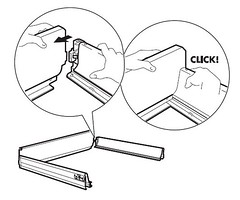
The problem is, things never quite "click" the first time. You mess with it and mess with it, and then you either figure out what you're doing wrong, or you drive 50 miles round trip to IKEA to exchange it for one that does click, or you throw it against the wall, where it makes a far more satisfying "THUNK" sound. To be fair, some of the things we've purchased come in large numbers (such as cabinet hinges). Once you figure out how to make them click properly, it's usually not hard to get the rest to click as well.
In my efforts to complete these cabinets, I've discovered two major design issues. The first design problem is that the cabinet shells have three different-sized holes drilled partway through them. The largest is for cams (used to tighten components together), the middle size is for wooden pegs (used to hold components together), and the smallest is for screws to attach brackets or shelf supports. The problem is that the middle-sized hole is exactly the size of the screw head used in the smallest hole.

If you fumble while screwing (and who hasn't?), you may drop a screw in such a way that it falls into one of the middle-sized holes, as I did. If the middle-sized peg holes were just a tiny bit smaller, the screw wouldn't fit. If they were a tiny bit larger, you could just shake the screw out.
There is no way to extract the screw, because they're non-magnetic. I tried digging it out, pounding on the cabinet from the other side, even bending over and sucking on the hole. Nothing worked. And of course, I couldn't just leave it there, because IKEA only gives you exactly the number of screws you need to complete the assembly. I was forced to drill a hole in the other side of the cabinet, to push the screw out from the other side.
The second design problem is that IKEA is always trying to save money, to ensure that their cabinets are cheap enough to satisfy the female equation. So the assembly instructions for cabinet hinges are printed on the package, rather than on a booklet contained in the package. This is a great idea for saving paper, but then some moron in the shipping department pastes the order label on the package, obscuring the instructions. The label is attached with some kind of industrial adhesive and cannot be removed without destroying the package.
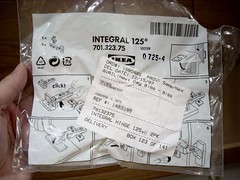
It took me an hour of fumbling and cursing and holding the package up to the light to finally decipher the assembly procedure.
A little over 12 years ago, we moved from Boston to Florida. For 12 years, I’ve been questioning the wisdom of that decision. Every time we take a drive and some new strip mall has popped up out of nowhere, or a wooded area is cleared for another tract of cheaply-built, closely spaced houses, I remember living in a city that has been “built out” for a hundred years.
We took a stroll around the city on a chilly, overcast day (commonplace January weather in Boston). The streets are a messy, winding tangle, because they were laid out by cows wandering to pasture back in the 1600’s. Somehow, developers managed to build beautiful buildings in the odd negative spaces left available. For example, here’s a building that has a gentle, gracefully curved façade, following the curve of the street below:
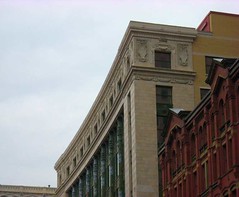
Back in the early days, even functional buildings were constructed with decorative detail, giving the city a rich texture not found anywhere in Florida. Here’s South Station, emblazoned with Ionic columns.

Boston's small Chinatown district is marked by this cool, traditional gate:
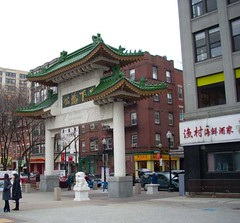
Because Boston is the capital of Massachusetts, the State House is located there. It sits on top of Beacon Hill adjoining the Boston Common (a city park where cows were once permitted to graze). The dome is gilded and gleams like a beacon on sunny days. However, it was painted black during World War II so it would be a less visible as target for enemy bombers.

I like the Massachusetts State House, but surprisingly, it’s less imposing than that of Rhode Island, the tiniest state in the union. Even more surprisingly, it's not the original State House. The tiny original state house still stands in the city, but we didn't pass it on our walk.
Everywhere you go, there are plaques or bas-reliefs identifying historical events or locations. This small one identifies the birthplace of Ralph Waldo Emerson, a 19th century poet. And he’s just one of many noteworthy poets who lived in the Boston area.

There’s not much history in Florida, and what little there is, most people seem content to forget.
In Boston, care is taken to preserve old buildings wherever possible. Here, the buildings on either side of this gothic masterpiece have been removed (presumably to replace them). Braces have been put in place to keep the grand old building from collapsing.
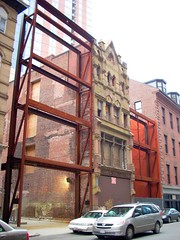
We visited Faneuil (FAN-yewl) Hall, where famous patriots such as Samuel Adams made impassioned speeches advocating independence from British rule. In Florida, Samuel Adams is a brand of beer.

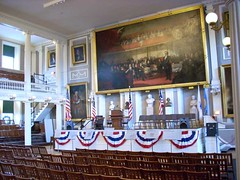
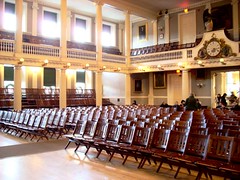
Boston has a thriving, if small, Chinatown section. When we lived in Boston, we used to go with friends to have Dim Sum about 3 or 4 times a year. We can get Dim Sum in Florida, but it’s not the same. While we were visting in Boston, we went out with a big group of our friends. Fortunately, most restaurants that serve Dim Sum anticipate large family groups, so they have lots of big round tables.
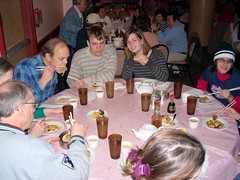
For those of you who may be unfamiliar with Dim Sum, it’s a kind of Chinese smorgasbord brunch. The food is continuously being prepared in the kitchen, and servers wheel around carts carrying the most recent offerings to your table. The food is primarily small portions of dumplings, custards and buns, with occasional ribs, shrimp or shellfish dishes. The portions are delivered on a plate or in a steamer. People take what appeals to them, and everyone shares, family-style. Here’s a typical cart, carrying shrimp and stuffed mussels.

In Boston, Caucasian people at Dim Sum are a significant minority. The wait staff speaks Chinese, for the most part. Usually, if you don’t speak Chinese (I don’t), you can make yourself understood by pointing at what you want and holding up fingers to indicate how many.
The server hands you your order, then picks up a bill on the table and stamps it to indicate what you’ve ordered. The bill is tallied when you leave. The only problem with Dim Sum is that if you don’t read Chinese, you have no idea what the meal will cost:
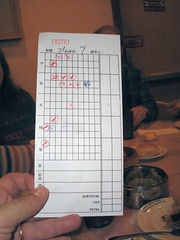
One of the delights of Dim Sum to us non-Chinese people is that the dishes are all pretty mysterious. Unless you go often, most of the food is unidentifiable. Pretty soon, the table is littered with tasty morsels, and everyone picks away at it:

Of course, some people are a bit put off by the food, which does not resemble American food in any way. One friend of ours wouldn’t touch anything, because she said it all looked like “placentas.” Another friend of mine gagged at the sight of a dish containing a duck-meat meatball clutched in the foot of the duck who had donated the meat. My daughter, a skeptic, examined her food closely before trying it.

Not everything is a treat. We ordered a plate of these things, which everyone referred to as “implants.”

I managed to remove a bite-size wad of one and tasted it, to everyone’s amusement. It tasted like half-congealed Elmer’s glue, covered with coconut sprinkles.
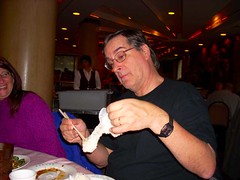

I imagine the guys in the kitchen dreaming up these weird things and telling the servers to wheel them by the Round-Eye’s table. Bets are placed, and if anyone eats it, one of the cooks goes home with wads of cash.
Like many homes in Florida, we have a pool with a screen enclosure. On one end of the enclosure, there’s a hedge, which screens the pool from the neighbors on that side. On the other end, there’s a large Bird-Of-Paradise plant, which serves the same purpose.
Unfortunately, our neighborhood backs up to a wildlife refuge, which means we are visited frequently by deer, and occasionally by black bears. On one occasion, I discovered one gourmet bear half-inserted into one of our garbage cans. “Bon appetit,” I muttered, backing away slowly.
A few months ago, I woke up and discovered that during the night, something had torn out huge stalks of our Bird-Of-Paradise plant, and spent the evening chewing on the soft tender ends. The plant is irreplaceable, standing nearly 10 feet tall. It would take years for a new one to grow that large.
So I did a little research on bear repellant. It seems there are only two varieties: The first is pepper spray, which is only used in the event of a bear attack. The second is electric fencing. I had no intentions of building an electric fence around my plant, so I hoped the bear wouldn’t come back.
Unfortunately, he did. For three nights in succession, each time tearing away large parts of the plant. But then, in a moment of clarity, I had an idea. That night, I went out and urinated on the Bird-Of-Paradise. I thought it might establish a territorial claim, or at the very least make the plant unpalatable. To my amazement, it worked. I pissed on that plant every night for a week, and never saw any sign of the bear.
But then I stopped, and days turned into weeks, weeks turned into months. Two days ago, I found this:
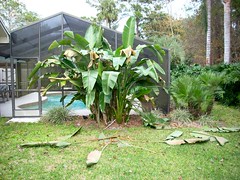
Here’s a close-up, with a dollar bill to show the size of the stems the bear has been tearing off.

So I repeated the urine treatment and the bear hasn’t touched the plant.
If you’re interested, you can have a 4-ounce bottle of my Florida Bear Repellant for $3.99 plus shipping. Operators are standing by.
My recent post on the subject of our sledding excursion reminded me of a sledding hill near my house when I was a kid. We called it “Suicide Hill.” Over the years, I’ve discovered that every kid who grew up in a snowy area had a local hill that bore the same name.
But when I ask about the features of the hill that entitled it to bear such a threatening name, the answers are always kind of vague and not very threatening at all. “It’s really steep,” they say. Or, “There were trees on the way down.” Well, trees aren’t much of a threat if you know how to steer a sled, but I suppose if you’re a novice, they can be intimidating.
I’ve never heard of a Suicide Hill that was quite as terrifying as the one in my neighborhood. It was located at a local golf course. You started on one of the tees, swooped through a glade of trees, flew over a jump, and had only an instant to correct your course before you had to cross a narrow golf cart bridge over a 6-foot deep paved culvert. At the bottom of that culvert was an icy stream about two inches deep, studded with sharp rocks. Here’s a diagram:
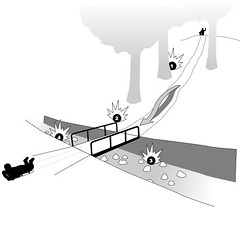
There were four ways to injure yourself:
- Hit a tree. It's a minor obstacle, but not one you should ignore. Potential: Broken fingers, bruises.
- Hit the steel bridge railing. This is possibly the greatest danger, since the bridge is only about 4 feet wide. Potential: Broken arm, broken collarbone.
- Plunge into the stream. Bailing out of your run will toss you onto the rocks. Potential: Serious bruising, humiliation, and the possibility of hypothermia or frostbite as you limp home.
- Fly into the opposite paved bank. The only thing worse than bailing out of a bad run and suffering the teasing of your friends. Potential: Broken arm, fractured skull, serious bruises, and of course, the frostbite.
Does anybody have a better Suicide Hill?
When I was a kid, I lived in a part of the country that received regular snowfall during the winter. Everybody had a sled, and they were all pretty much the same Flexible Flyer design: wooden deck, narrow steel runners, and a steering yoke. They were sturdy and heavy, but they wouldn’t work in all snow conditions. But the worst part was dragging that monster back up the hill for your next run.
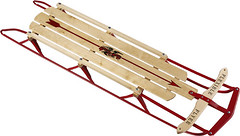
We became experts at looking out the window and making the calculation to determine whether to get the sled out of the garage. Because it wasn’t worth the trouble of hauling the sled to the hill and dragging it back up if you weren’t going to get a thrilling ride. Thank goodness, sledding was a kids-only activity, because our parents would have been horrified at some of the things we did to achieve that thrill. The primary reason that adults didn’t participate is that it’s hard work climbing that hill after a run. Kids can go for two or three dozen rides. Adults are lucky to make a dozen.
Sled manufacturing took an interesting turn back in the 60’s, when cheap plastic sleds became available. They were durable and lightweight, which meant you could get more runs in a given time frame. But they had no steering to speak of, which limited the places you could use them.
On our recent visit to Maine, I discovered that the sledding industry has another interesting development up its sleeve: snowmobiles.
In Kingfield, Maine there’s a great sledding hill called Gilmore Hill. It’s wide, long and steep, but it’s not so steep you can’t climb back up. It’s unobstructed by trees, boulders, fences, angry territorial dogs, or anything else that might detract from the experience.
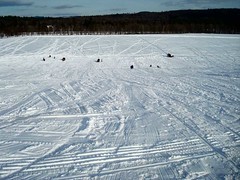
What I found most intriguing is that thanks to snowmobiles, sledding has become a family activity. There were several family groups at the hill, comfortably seated in lawn chairs, noshing on sandwiches and sipping hot cocoa. The kids would fling themselves down the hill on their sleds, and one of the adults would hop on a snowmobile and drag the kids back up the hill. This way, the kids could sled all day without wearing themselves out.
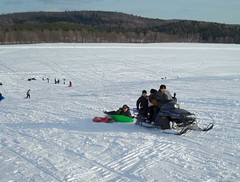
One guy even brought some kind of Arctic Cat with tank treads, capable of hauling a dozen sledders at a time.
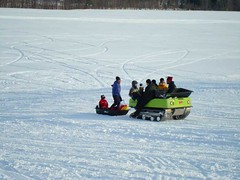
We weren’t so lucky. Since we didn’t know anyone with a snowmobile, we had to come back up the hill the old fashioned way. Here are the ladies smiling and jovial as we began our sledding adventure:

Here they are, climbing back up that hill after a ride:

And here they are after a few trips:
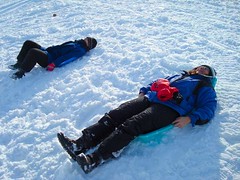
So the sledding equation has changed for kids with families that own a snowmobile, but it hasn’t changed at all for me. I showed up in ski overalls, a puffy ski jacket, gloves, boots and thick undergarments. After a few trips up that hill, I felt as though a Hawaiian shirt and a pair of Bermuda shorts would have been more appropriate.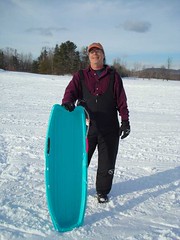
My daughter has been growing her hair long, against our wishes. We don't want her to grow it out because she has a tendency to develop huge knots the size of large, well-fed mice. They have to be picked apart slowly, or in serious cases, cut out.

She did it for a good cause, however. There's an organization called Locks of Love, who take donated human hair (minimum 10 inches long) and make it into wigs for needy pediatric cancer paitients who have lost their hair as a result of chemotherapy.
It's a pain to take care of hair that long, and she's been anxious to cut it off. After we returned to Boston from Maine, we rented a car and made an appointment at a local hair salon.
The car we rented was a Saab 93, a sporty little sedan, and my wife fell in love with it. Unfortunately, I somehow hurt my back and couldn't drive. The temperature in Boston plummeted into single digits, and the streets were coated with sheets of ice. My wife didn't let that slow her down, and she sprinted around in that hot car like she was being chased by the police.
We arrived at the salon, which was bustling with customers at 5:00 p.m. I assumed that this was because so many women are now working, salons must stay open after normal working hours. The stylist wasted no time, tying rubber bands around bundles of hair and lopping them off.
My daughter had picked out this style:
http://hairstyles.hairboutique.com/GD/11815/
The stylist worked on her hair for a surprisingly long time, layering and structuring the cut. Meanwhile, around me, other women were having their hair done, undergoing elaborate procedures involving caustic substances requiring the stylists to wear rubber gloves and protective goggles. I have no idea what all of this costs, but I think it's fair to say that most men are clueless about the stuff women go through to look the way they do.
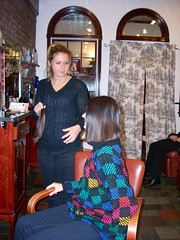

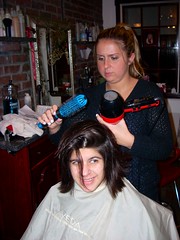
When it was all over, my daughter was thrilled and giddy.
